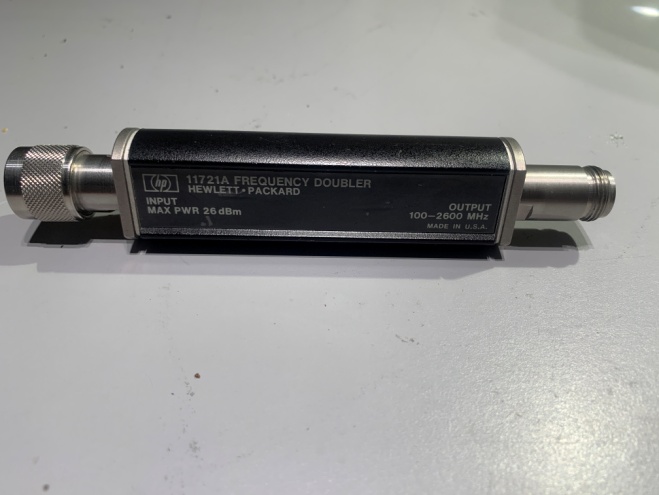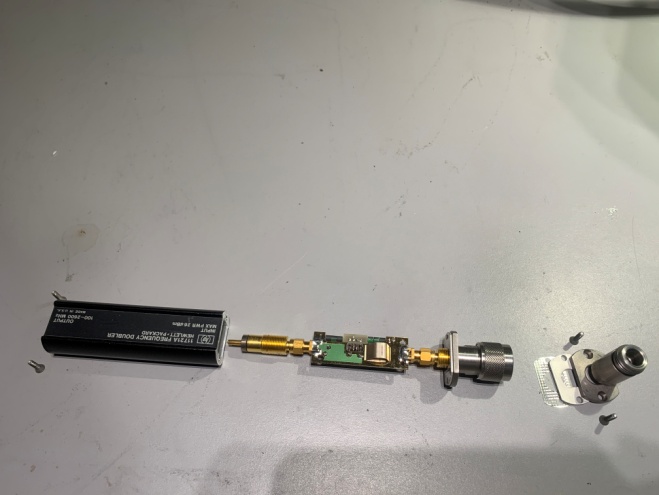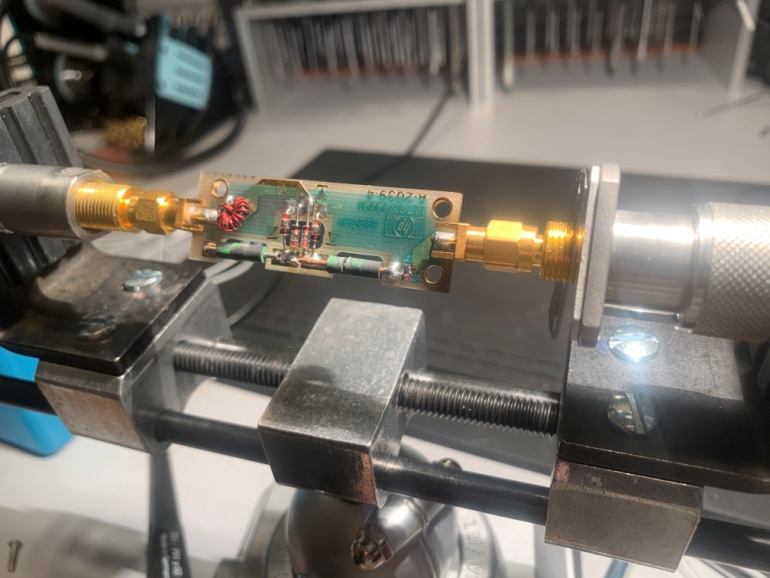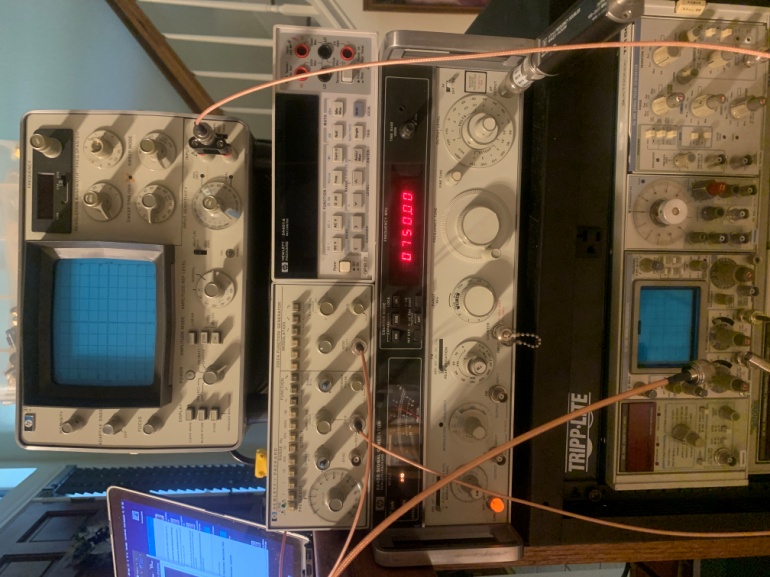I was looking for a cheap doubler and came across this unit from Korea. It took almost 6 weeks to get here, some sort of customs holdup. This doubler covers an input range of 50-1300 Mhz. My intent with this was to provide an external doubler for my HP8640B. This item was designed by Bob DeVries of HP.

It arrived thrown in a envelope with about 10 microns of foam. Not good. I opened up the package and oddly enough, no damage to the body or N connector. Good.
Since this is basically a passive device with a full wave bridge and some harmonic suppression, I just plugged it in to see what we have. Nada…zip….nothing. Well, hell…what did I expect from a $20 purchase from Korea ?
Let’s have a look at the serial numbers so we can get an idea of the age. For serial numbers in the format xxyyAnnnnn adding 60 to xx is the year made, yy is the week, the letter is the country where made.
For S/N= 1950A00703:
* 19 -> Made in 1979
* 50 -> Week # of last production change
* A = America, J -> Made in Japan, G = West Germany, U= United Kingdom
* 00703 actual serial number of instrument
The series prefix doesn’t represent the date of manufacture. Instead, it represents the date of the last production change that affects form, fit, or function, or for other modifications such as firmware version changes. They use the series prefix to tie production changes (changes in production documentation) to changes in customer documentation. So, for this unit, it was built in late 1979 making it 41 years old.
Dug out a manual, and lets pull this guy apart.

Pretty simple, 4 diodes, a small toroid, & some ferrites.

Checked the diodes, all shorted. Yup…somebody fried the thing. Lets see if we can find any replacements…..

Well, double hell…These are matched diodes. HP part # is 1906-0098
Let’s check our cross-ref guide for any replacement parts..
Nope, no cross reference, that makes it an HP unique part. Let’s see if a search can find anything…
I did a quick ebay search and came up with a matched quad HP# 5082-2815 in the same discrete axial packaging as the original. It’s rather challenging to find a solution here without benefit of the original diode specifications. I can only assume that the originals are Schottky barrier diodes with matched IV parameters.
The proposed matched quad has the following characteristics (from the ebay ad). I’m not sure on the 250mw rating but it seems pretty reasonable. Probably not a great solution if you reverse power the output terminals, but I’m sure the original had the same problem (hence, 4 shorted diodes).
|
Characteristic |
Specifications |
|---|---|
|
VOLTAGE RATING IN VOLTS PER CHARACTERISTIC |
15.0 MAXIMUM COLLECTOR SUPPLY VOLTAGE |
|
CURRENT RATING PER CHARACTERISTIC |
20.00 MILLIAMPERES MAXIMUM FORWARD CURRENT, DC |
|
POWER RATING PER CHARACTERISTIC |
250.0 MILLIWATTS MAXIMUM FORWARD POWER DISSIPATION, MAXIMUM PEAK, TOTAL VALUE |
|
CAPACITANCE RATING IN PICOFARADS |
1.2 MAXIMUM |
|
MAXIMUM OPERATING TEMP PER MEASUREMENT POINT |
200.0 DEG CELSIUS JUNCTION |
|
INCLOSURE MATERIAL |
GLASS |
|
MOUNTING METHOD |
TERMINAL |
|
TERMINAL LENGTH |
1.000 INCHES MINIMUM |
|
TERMINAL CIRCLE DIAMETER |
0.014 INCHES MINIMUM AND 0.016 INCHES MAXIMUM |
|
TERMINAL TYPE AND QUANTITY |
2 UNINSULATED WIRE LEAD |
|
OVERALL LENGTH |
0.150 INCHES MINIMUM AND 0.170 INCHES MAXIMUM |
|
OVERALL DIAMETER |
0.068 INCHES MINIMUM AND 0.076 INCHES MAXIMUM |
|
FEATURES PROVIDED |
HERMETICALLY SEALED CASE |
|
SPECIAL FEATURES |
R/N HP5028-2815 IS QUAD MATCHED SET OF HP5028-2811 SCHOTTKY BARRIER DIODES |
Looks like a suitable solution, so I ordered the $20 matched set for a try.
Once the diodes arrived, I pulled the original diodes and replaced with the replacement quad. I then fired it back up and…zip…nada. Well, lets dig a little deeper. After looking at the schematic, something isn’t right with W1/W2 jumpers. These were replaced at some point, improperly. W1/W2 are .047 micro semi-rigid coax. Unfortunately, whoever replaced them failed to correctly terminate the W2 jumper. W1 uses the outer shield ONLY, whereas W2 uses the shield & core. The W2 core was cut off and replaced without terminating the core. Well, that would explain things.
I managed to find some short semi-rigid stubs online that were almost exactly the same length. While waiting, I checked the matched diodes I previously pulled and they all read properly. Diodes weren’t bad after all. I decided to leave the new ones in for now, as they have a higher breakdown voltage.

Image showing the W2 jumper installed properly (copper jacket). Note the w2 core terminates to an adjacent pad (this was improperly cut off).

Image of W2 input termination. This was also cut off improperly and repaired as part of the W2 assembly.
OK, lets reassemble and see what we’ve got…
Fired it up and voila….signal !!!

This image shows an 8640B coupled to the doubler, with a 375 Mhz fundamental. This is doubled to 750 Mhz. This appears to work well to 1Ghz. My SA is out for cal at the moment, so I just threw it up on my Lecroy WR64Xi for a peek. The scope only has a 600Mhz bw, so not exactly a great test but close enough to see the output.

The sampling is falling on its ass here, as you can see the aliasing. However, we have a doubled output from the HP 11721A !!! Signal level looks about right when you take the insertion loss of the doubler into account so I’m gonna declare this “almost complete”. Once I get the SA back I’ll check the harmonics & spurs over the full 2.6Ghz range of the doubler.
